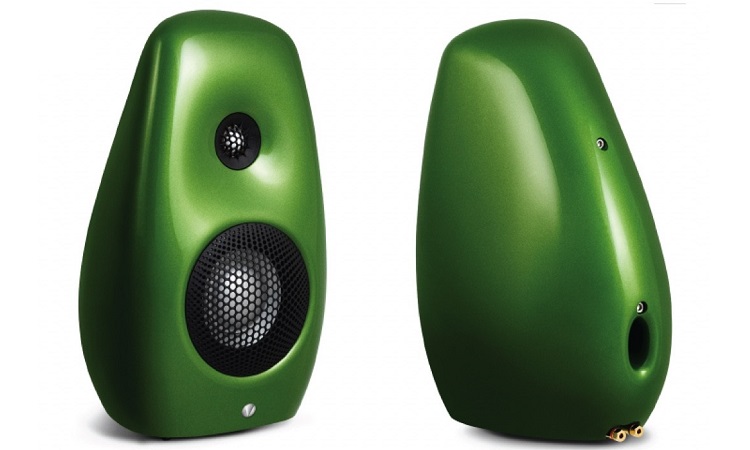REVIEW: VIVID KAYA S12: The Vivid Kaya S12 is a mini monitor. Seems harmless, has a ‘nothing-to-be-wrong’ appearance and a certain degree of cuddlyness. Once inside, the true nature manifests. Perhaps comparable to your mother-in-law. Therefore an introduction.
Vivid Audio
Vivid builds loudspeakers that keep the minds of critics and music lovers busy. After all, Vivid is synonymous with innovation. Not a manufacturer that simply builds loudspeakers in mass, according to concepts that have been in existence for 50 years. No, those who listen to a Vivid experience something new. Another step towards realistic sound. The difference between listening to your hi-fi equipment or listening to the music.
There are hundreds of speaker brands in hi-fi, with just as many models per brand. Amazingly, new brands are still being added. Speakers and hi-fi products have become a commodity product. Just like dishwashers and coffee makers. Loudspeakers are small, living room-friendly, business as usual, often have a nice design, apart from the mains connection they are ‘wireless’ and certainly sound good nowadays. But the real innovation is carried by a limited number of brands and individuals. That is no different in hi-fi than in many other sectors.
Only a limited number of groundbreaking loudspeakers were designed and built between 1930 and 1980 that really improved performance fundamentally and convincingly. In aviation, we are in about the same time span from Lindberg’s Spirit and Fokker’s Spinflew to the 747 and Airbus A380. Much more progress than within hi-fi. Laurence Dickie deserves the honor of being part of the world’s most innovative loudspeaker engineers. He also clearly indicates that Vivid is not a loudspeaker designer, but a research organization. Laurence has made a name for itself with the matrix housing and the Nautilus for B&W (from 1983). For Turbosound he developed a number of horns with exemplary radiation properties and at Vivid (from 1997) his work resulted in the dust-blowing G1 in 2008.
Vivid Kaya S12
Anyone who would come across an S12 on Marktplaats or on Waterlooplein will probably pass it by carelessly. A small ‘plastic’ speaker, which hardly weighs anything and does not stand out due to flashy colors and screaming layers of paint, although Vivid delivers a version in piano black and in colors of your choice. That is a missed opportunity. Finally the holy grail is in front of you and you don’t even recognize it.
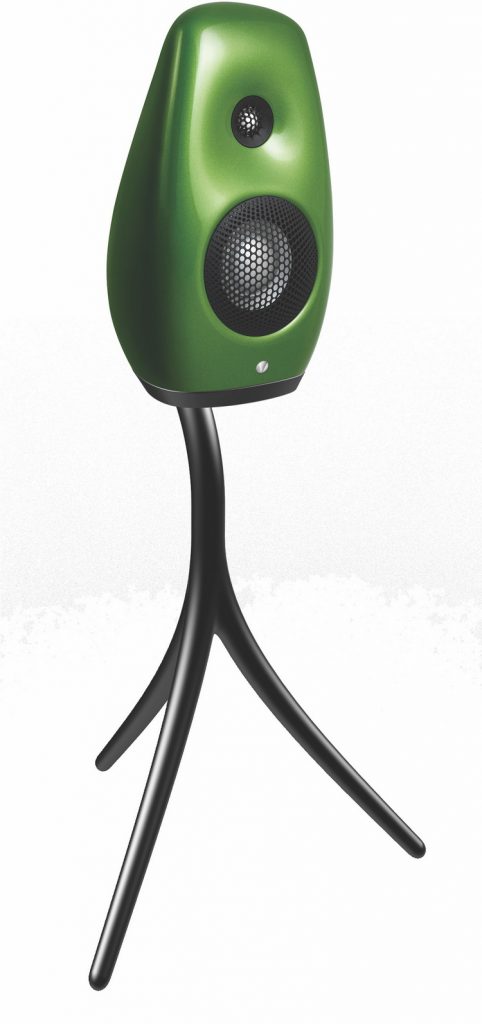
This omission may also not be covered by insurance. But, with a height of 48 cm, a capacity of 12 liters and a weight of 6 kilos, this S12 can easily be seen as yet another computer speaker. However, Vivid itself speaks of ‘Small footprint, giant performance’. This is usually not reflected in the standard specifications in the brochure. Two-way system with a port, 87dB efficiency, 45-25,000Hz frequency range within -6dB points and then dimensions, weight, standard colors, colors to order, wall mounts, stands and so on. How many do you want? But, just digging through it gets more exciting. This small Vivid has the famous tube loaded reflex of the big Gaya G1. There is a new long throw C100D bass / mid driver and the well-known ‘tube loaded’ D26 tweeter from the Vivid range.
Technic
Although the S12 looks fancy, modern and attractive, the housing is not just designed to put a trendy design on the market. It really is ‘form follows function’ here. The S12 was created after three years of development time and is intended as a monitor next to the floorstanders in the Kaya line. Think of the Kaya 25, 45 and 90. A standard loudspeaker with the well-known plan-parallel six boards has a lot of internal resonances. Sound reverberates between all those surfaces and usually the resonances in the longitudinal direction of floorstanders are more problematic than the lateral movements. With a small monitor, according to Vivid, those lateral movements also turned out to be disturbing. Subsequently, an absorber was built in the shape of a tetrahedron. That is a somewhat more complex mathematical form. This absorber dampens resonances in all directions. The big additional challenge was to set it up in such a way that the ‘sound output’ from the bass reflex port would not be disturbed, which of course happens quickly if you mute internally in all directions. They succeeded, but the complex tetrahedron was not really suitable for serial production. This is where the shape of the housing comes into play. The back forms a ‘shell’, which is covered on the inside with a kind of wings. They dampen all resonances in all directions, but do not disturb the low energy via the bass reflex port. So a somewhat more practical form, derived from the tetrahedron. The C100D bass / mid driver then also benefits from the lack of resonances and will logically be able to ‘sound’ very tight and neutral as a result. But the further design of the S12 housing was also not thought up at random, because it looks so nice. The tweeter is placed in a horn-like waveguide. This gives you extra output, but you also influence the time-alignment of the entire system. It is essential that the polar response of the tweeter matches that of the bass / mid driver. If not, the frequency response in the off-axis region is not linear. Because this is in order with the S12, it becomes completely clear theoretically why the S12 achieved such an exceptional performance during a further stage of tuning. Something that simply does not work with many other monitors. Finally, the shape of the housing also has to do with the avoidance of diffractions. This gives you extra output, but you also influence the time-alignment of the entire system. It is essential that the polar response of the tweeter matches that of the bass / mid driver. If not, the frequency response in the off-axis region is not linear. Because this is in order with the S12, it becomes completely clear theoretically why the S12 achieved such an exceptional performance during a further stage of tuning. Something that simply does not work with many other monitors. Finally, the shape of the housing also has to do with the avoidance of diffractions. This gives you extra output, but you also influence the time-alignment of the entire system. It is essential that the polar response of the tweeter matches that of the bass / mid driver. If not, the frequency response in the off-axis region is not linear. Because this is in order with the S12, it becomes completely clear theoretically why the S12 achieved such an exceptional performance during a further stage of tuning. Something that simply does not work with many other monitors. Finally, the shape of the housing also has to do with the avoidance of diffractions. then the frequency response in the off-axis region is not linear. Because this is in order with the S12, it becomes completely clear theoretically why the S12 achieved such an exceptional performance during a further stage of tuning. Something that simply does not work with many other monitors. Finally, the shape of the housing also has to do with the avoidance of diffractions. then the frequency response in the off-axis region is not linear. Because this is in order with the S12, it becomes completely clear theoretically why the S12 achieved such an exceptional performance during a further stage of tuning. Something that simply does not work with many other monitors. Finally, the shape of the housing also has to do with the avoidance of diffractions.
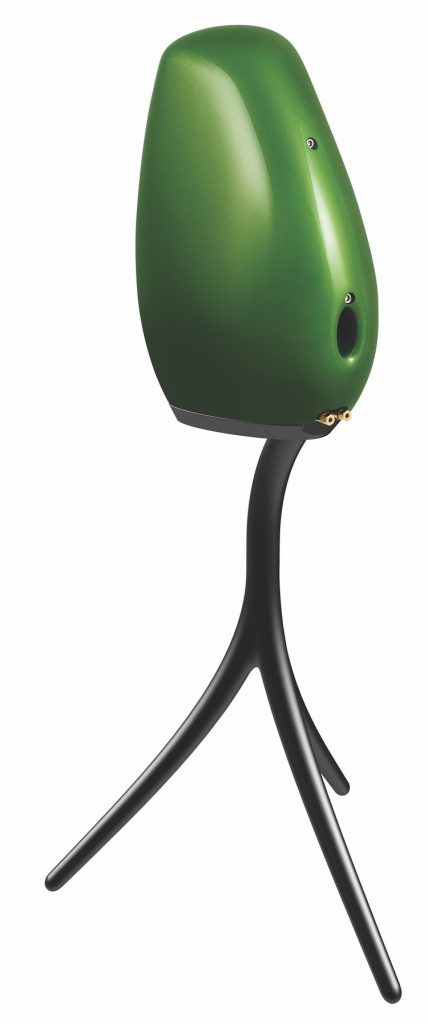
The Review
How does a review generally start? When it comes to loudspeakers, a choice is made on the basis of the properties of such a loudspeaker for suitable electronics that could match well. This often stems from previous experience, sometimes from measurements and sometimes from lists of specifications. Such a set is then quickly built up and listened to for a while. That is a defining moment. The components cannot yet be at operating temperature and loudspeakers may not have been tuned in yet, but such a set must be correct and show a certain potential. If not, the match can still be reconsidered, but it just has to perform above average. If that doesn’t work, you better stop. That’s just the end of the review. Otherwise you will end up in a process that many audiophiles are familiar with. Years of working on a system, always trade in, buy again and eventually achieve something after ten years or just zero progress. Often caused by a total mismatch of components and major problems with acoustics and setup. The Vivid S12 was actually well positioned from the start and played very convincingly. The term ‘shockingly well’ certainly fits here. Rarely has a small monitor been heard here with such crushing dynamics, superior focus, neutrality, drive and stage. The speed of these reproducers is really state of the art. The stage image is also very good. And the rendering of the midrange is of very high class. However, the S12 is a relatively small monitor. For the S12, the quality (definition, speed, neutrality) of the bass is very good, but such a monitor does not go in the direction of 20Hz. Normally you provide such monitors with a subwoofer, but it is also possible to move speakers a little closer to the back wall. The bass then increases, but the spatiality decreases. With a little toe-in, the depth of the image can increase slightly, but then the width of the stage will be slightly less.
There are also some acoustic properties of the room at play here and there is also a relationship with the control. A class-D amplifier has a lot of power in the low end. Then the speaker can move forward a bit. However, it will be clear that the final placement is always some kind of compromise. However, with a bit of good placement, the S12 can deliver enough low to listen to most of the music. The stage rendering of the S12 is very good, but a stage can of course also have different qualities.
Often a stage is simply that the vertical plane, within which the music manifests itself, is simply moved as a whole to a position behind the speakers. There are then few depth differences between voices and instruments. However, it is already beneficial if the sound is not discernible from the two speakers. You sometimes listen to two holes where sound comes out and then there is no spatial representation at all.
Potency
Listening to the very good performing system, in a kind of ‘standard setup’ around the S12, it starts to itch. Most mini monitors often give a somewhat ‘smaller picture’. It’s different from what’s possible with large floorstanders and systems like the Genesis 1, the Infinity 5, the PMC Fact Fenestria and the Lyngdorf LS. They are more space-filling and capable of a convincing live stage presentation. A feeling then says that much more could be obtained from such a Vivid S12, although a consumer at home could already be very enthusiastic about how the system initially performed. That was absolutely first class. Well, the undersigned always takes a Sardinian pleasure in really pushing the limits of audio systems. See it as a deviation, as a kind of top sport,
After a visit to shows or shops, you are sometimes left with the feeling that it sounded good, but that there really is more to get out of such a product. In audio you should never rely on your gut, just measure, read the theory and arrive at logical conclusions and actions. In any case, the secret booklet with the most bizarre tuning tricks was consulted and a strategy formed to get a little more out of the S12s. This booklet has been compiled over the years on the basis of experiences, conversations with colleagues from the (pro) audio world, from comparable booklets by professional (American) tuners and inspiration gained from contact with great teachers who were willing to share their knowledge. to share. An example was Ken Ishiwata. He once demonstrated two small speakers, controlled with a Marantz set with a retail price of no more than 3K. Then there was an image of the Concertgebouw Orchestra, roughly 6 meters wide, with a sublime illusion of reality. The collected world press was perplexed and did not understand anything about it. The trick is in the mentioned booklet. The approach, in general, basically consists of following theoretical models of how loudspeakers with a particular construction principle interact with space and with electronics. The acoustics of a room offers certain possibilities, but there are also impossibilities. You can then manipulate what is possible (available in a particular listening room). That means that something like this is simply not possible in some rooms. Electronics can also be a limiting factor, but that was by no means the case here.
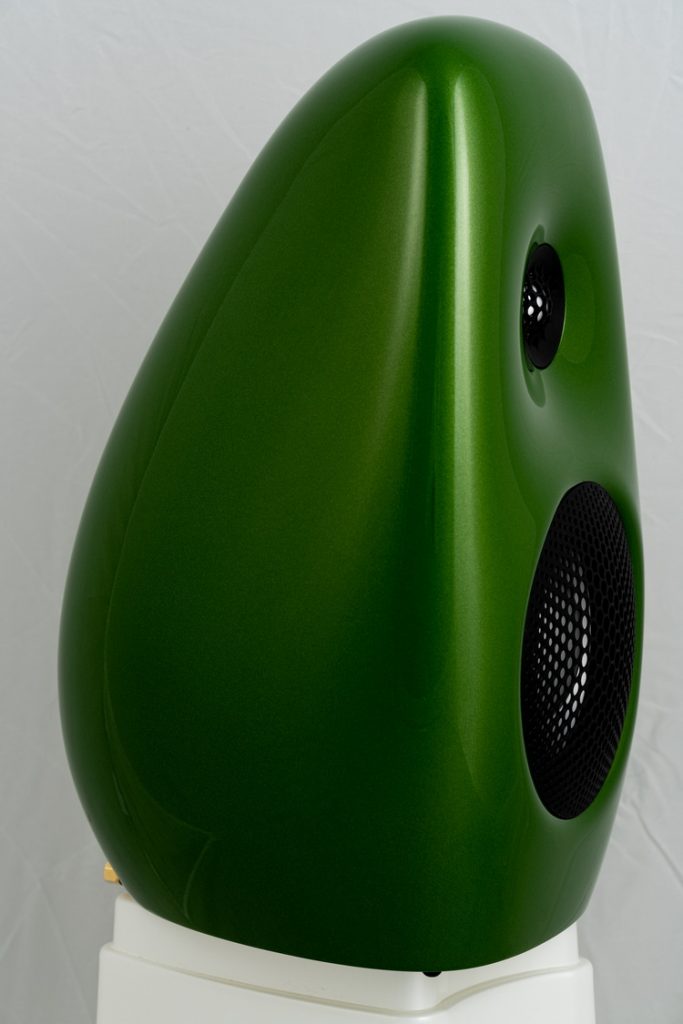
The result was remarkable to say the least. The beautiful, but somewhat more modest stage gave way to a spatial impression that goes in the direction of a live experience. No longer the feeling that speakers are playing, but as if you are looking at a stage with a number of musicians. Such a sound is three-dimensional. If you listen to live music carefully, you will experience that instruments and voices have a different place in the horizontal plane (depth and width), but also in the vertical plane. Sound also rises from a piano and you can perceive and experience that. Voices and instruments basically have a spherical radiation. This creates much more of a 3D representation. This is more difficult to realize with speakers. That’s why the radiating loudspeaker was invented, but this principle raises theoretical questions. Due to the generated reflections, the recording acoustics mixes with the acoustics of the listening room.
An omnidirectional loudspeaker therefore works best for reproducing completely dry program material. So a recording without acoustics. But that is also too short-sighted. There is again a theoretical framework that nuances this image and places radiating systems in a different light. By manipulating with the Vivid S12 and choosing other interactions with the acoustics, a much more natural 3D appearance was created. The image got more dimensions, became bigger, but kept the correct dimensions of the instruments. Height differences and clearer depth differences arose in the playback and the feeling that speakers were being listened to disappeared. It was just like listening to live music with the stage in front of you 5 meters away. The bass moved down two octaves. It didn’t reach 20Hz, Such an arrangement is of course also a compromise. This is because instinctively an experience is created as you experience it at a somewhat greater distance from the stage. The amount of direct sound then decreases slightly and with it the focusing.
The tuning and arrangement in a room of a system is therefore always the result of a consideration and remains a compromise. Either way, due to the shockingly good detailing, speed and focus of the S12, it was sensational to follow the dying out of sounds, and the path such sounds travel within the original recording space. You can follow reverb patterns completely. A sound image that comes close to reality. Not least because of the enormous speed of the S12. It seems as if there is no time layer during the start of (percussive) sounds and also that the slow or faster decay of sound (decay) is not hindered by added resonance behavior in the housing, the drivers and the electronics. These are all phenomena that make us experience sound as less realistic.
Electronics
Electronics also play a role in such experiments. The source, in the form of a Grimm MU1 server and a Mola Mola Tambaqui DAC, naturally provides a sublime signal. A power amplifier can be controlled directly from the Tambaqui. As an experiment, the power amplifier was replaced by another accidentally present one. The whole magic was completely gone. The sound no longer had a 3D character, but was on the same horizontal line behind the speakers. It was a dramatic difference. So, don’t blame the speakers. How you can achieve a more holographic, grander and more natural reproduction with loudspeakers like this Vivid S12 and suitable electronics fits the advice that the dealers of Terrason Audio can provide.
Epilogue
The Vivid Kaya S12 is a mini monitor with an attractive trendy design. Initially seems as innocent as the average attractive computer loudspeaker at the Mediamarkt. Maybe you don’t take the S12 completely seriously. However, that may be the biggest mistake in your audiophile life. Form follows function. Every line, curve, rounding and surface of this beautiful plastic speaker has been thought through. Those who can tune well can use these monitors to build a system that creates a wall of sound. A real 3D presentation that hardly reminds you of listening to music through two small speakers. There is simply a stage in front of you with musicians. An almost perfect illusion, with a fabulous speed, detail, reality and neutrality. The rendering of the middle area is very nice.
The system is able to highlight the warmth and atmosphere of the recording. The bass is very tight, detailed and defined. It doesn’t go up to 20Hz, but with a very smart way of tuning it is possible to get within the octave where 80 percent of the music has the maximum low range, but that also works by placing a little closer to the wall. However, it will undoubtedly be exciting to equip these monitors with one or two subwoofers. The thought then goes to the SVS SV-2000PRO. It integrates in particular with very fast speakers. Is neutral, fast and above all goes extremely deep. There are tones measured here from 20Hz with a sound pressure of 95dB. The S12 will soon be in the listening room for a second try and will then run into this experiment. In any case, the S12 is an amazing product. In the perception of the undersigned, this is one of the best monitors in the market. In fact the result of innovative thinking, which really brought the reproduction of music to a higher level.
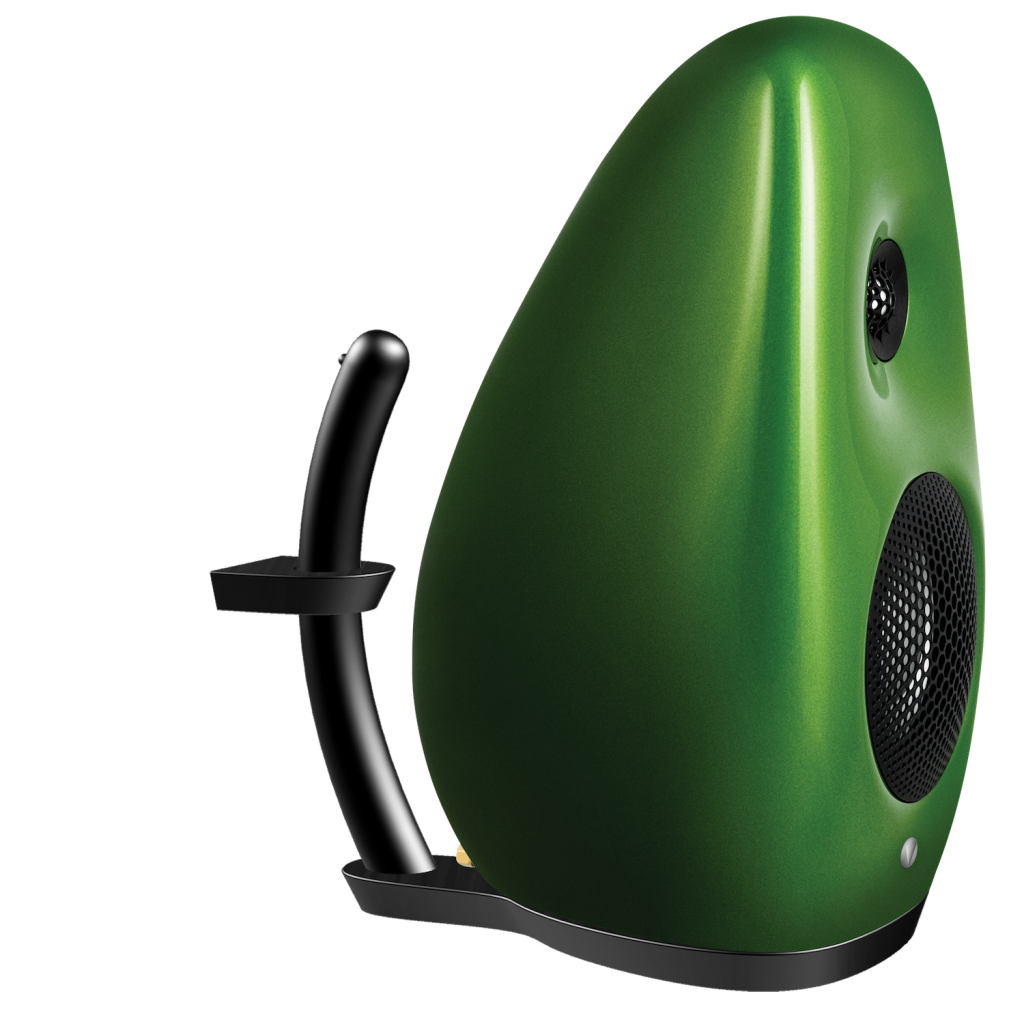
PLUS POINTS of VIVID KAYA S12
- Very compact
- Trendy and beautiful design
- State-of-the-art performance
- Superior speed, focus, dynamics and neutrality
- Beautiful middle area
- Well defined and quickly low
MINUSES of VIVID KAYA S12
- Choice of electronics requires some care
- Requires accurate placement due to the layer reproduction
